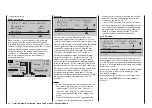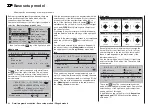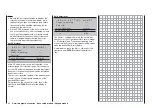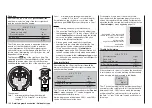
94
Detail program description - Model type | Winged models
This "Model type" menu is used to establish the type
of model to be programmed. This also activates
all characteristic mixers, coupling functions, etc.
in preparation for subsequent programming of the
specifi ed model type.
Model select
Ser vo adjustment
Stick mode
Control adjust
Dual Rate / Expo
Channel 1 cur ve
Switch display
Copy / Erase
Suppress codes
Suppress models
Base setup mode
l
Model type
Briefl y tap the center
SET
key of the right touch pad:
Motor at C1
After selecting the "Motor at C1" line with the
cd
selection keys of the left and right touch pad, the
corresponding entry fi eld will be framed.
Tail type
Motor on C1
Nor mal
None
Aileron/camber flaps
1 AIL
M O D E L L T Y P E
Brake Offset
Input 1
+100%
SEL
Briefl y tap the center
SET
key of the right touch pad:
The current setting will be displayed in inverse video.
Now use the selection keys of the right touch pad to
select from among the following four options:
"none"
For operation of a model without a
propulsion.
The warning "Throttle too high",
see page 30, is
deactivated
and
the "Brake settings" sub-menu of
the »
Wing mixers
« (beginning
page 172) is available without any
restrictions.
"Thr. min. rear":
The idle position for the throttle/
brake fl aps joystick (C1) is to the
rear, i.e. toward the pilot.
The warning "Throttle too high", see
page 30, as well as the "Thr. CutOff"
option in the »
Basic settings,
model
« menu, see page 81, are
activated
and the "Brake settings"
sub-menu of the »
Wing mixers
«
menu, beginning page 172, will be
available if the entry in the "Motor"
column of the »
Phase settings
«
menu, page 142, for the currently
active fl ight phase is "none".
"Thr. min. fwd.":
The idle position for the throttle/
brake fl aps control stick (C1) is at
the front, i.e. away from the pilot.
The warning "Throttle too high", see
page 30, as well as the "Thr. CutOff"
option in the »
Basic settings,
model
« menu, see page 90, are
activated
and the "Brake settings"
sub-menu of the »
Wing mixers
«
menu, beginning page 172, will be
available if the entry in the "Motor"
column of the »
Phase settings
«
menu, page 142, for the currently
active fl ight phase is "none".
Notes:
Be sure to pay attention during the
•
programming procedures that motors do not
start up unintentionally. Disconnect the fuel
supply or battery terminals to motors before
programming.
C1 trimming will operate according to the choice
•
made between "normal" or only "back" or "fwd.",
that is, either over the control's entire travel path
or only in the respective idle direction.
Tail type
After selecting the »Tail type« line with the
cd
selection keys of the left or right touch pad, the
corresponding entry fi eld will be framed.
Tail type
Motor on C1
Nor mal
None
Aileron/camber flaps
1 AIL
M O D E L L T Y P E
Brake Offset
Input 1
+100%
SEL
Briefl y tap the center
SET
key of the right touch pad:
The current setting will be displayed in inverse video.
Now select the type appropriate for the model with
the selection keys of the right touch pad.
"normal":
Elevators and rudder are each
operated by a single servo.
"V-tail":
Elevator and rudder control is
affected by way of two separate,
articulated, V-shaped rudders. The
coupling function for rudder and
elevator control will be automatically
taken over by the program. The
relationship of rudder-to-elevator
proportion is set in the »
Dual Rate /
Expo
« menu, page 120, and servo
travel in the »
Servo adjustment
«
menu, page 102.
If, beyond this, there is a desire to
also make differentiation for rudder
throw then the V-tail should be
alternatively controlled via the »
Dual
mixer
« menu, page 206. In this case
however, the tail type entry specifi ed
here
must
be "normal".
"ELEVON":
Aileron and elevator control is
operated by one or two servos
Model type
Establishing winged aircraft model type
Summary of Contents for 32032
Page 1: ...33020 mc 20HoTT 2 en Programming Manual o Pro Pro mc 20 mc 20...
Page 15: ...15 For your notes...
Page 21: ......
Page 27: ...27 For your notes...
Page 41: ...41 For your notes...
Page 53: ...53 For your notes...
Page 59: ...59 For your notes...
Page 63: ...63 For your notes...
Page 93: ...93 For your notes...
Page 97: ...97 For your notes...
Page 141: ...141 How is a ight phase programmed...
Page 145: ...145 For your notes...
Page 155: ...155 For your notes...
Page 175: ...175 For your notes...
Page 203: ...203 For your notes...
Page 219: ...219 For your notes...
Page 253: ...253 For your notes...
Page 283: ...283 For your notes...
Page 321: ...321 For your notes...
Page 322: ...322 For your notes...
Page 323: ...323 For your notes...
















































